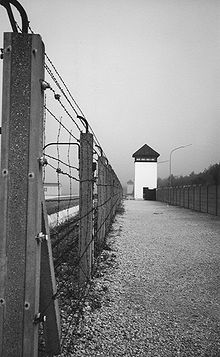Postenpflicht
The Postenpflicht (
Background

In May 1933, the Munich
New camp order
Theodor Eicke was commissioned to develop a new camp order and a new regulations handbook.[note 1] He wrote the Postenpflicht with instructions to fire on prisoners immediately and "without warning". Refusal to obey this order would bring serious consequences for camp personnel: summary dismissal and even arrest.[citation needed]

The "Regulations for Prisoner Escorts and Guards" (Dienstvorschrift für die Begleitpersonen und Gefangenenbewachung) were dated and went into effect on October 1, 1933.
The perimeter of the detention camp grounds was marked by electrified fences and walls. Alongside the wall was a moat and next to that was an area called the "neutral zone". Dubbed the "death strip" by prisoners, it was a forbidden area. A prisoner who even went near this area risked being shot by a guard invoking the Postenpflicht. Guards who shot a prisoner received a bounty and three days off. Guards, for their amusement and profit, would throw a prisoner's cap into the "death zone" and order the prisoner to get it "on the double" and then shoot the prisoner.[8][9] They sometimes did this in pairs because they received a bounty for shooting a prisoner, so they would take turns in order to both get the bounty.[7] Witnesses and former prisoners have also reported cases where prisoners intentionally walked into the forbidden zone, to escape the camp through death.[10]
Prisoner work details outside a concentration camp were called Außenkommandos ("outside commandos") by the SS. The SS guards would form a Postenkette, a cordon of guards to surround the work site and maintain watch. The imaginary boundary formed by the cordon was not to be crossed by a prisoner. Stepping outside the boundary was treated as an escape attempt and the guards, adhering to the Postenpflicht, were to fire without warning.[8] If a prisoner did manage to escape, the SS guard was charged with "negligent release of a prisoner".
The Postenpflicht was also valid for the SS-Totenkopfverbände that came to the concentration camps to serve as guards and auxiliary police.[note 2] During the war years, female guards were also employed at concentration camps. As overseers, they were also ordered to use their firearms in the case of physical attack by a prisoner or an escape attempt.
Reich Minister of Justice
Camp commandants were also held accountable to the Postenpflicht.
The "Postenpflicht" order

Dachau concentration camp
Headquarters, Oct. 1, 1933
Regulations for Prisoner Escorts and Guards
6. Postenpflicht
Whoever allows a prisoner to escape will be arrested and charged with Negligent Prisoner Release and handed over to the Bavarian Political Police.
If a prisoner attempts to escape, he is to be shot, without warning. A guard who shoots an escaping prisoner in the course of carrying out his duty, will not be reprimanded.
Where a guard is physically attacked by a prisoner, the attack is to be repelled with use of a firearm, not return physical violence. A guard who does not comply with this order should expect his immediate dismissal. Besides, he who "keeps his back free" [note 3] will rarely be attacked.
In the event of a revolt or organized prisoner resistance, every guard supervising is to fire upon them. Warning shots are strictly prohibited.[6]
See also
- Schießbefehl
- Negligence
- Kangaroo court
- Concentration Camps Inspectorate
- Treblinka resistance, August 1943
- Sobibór rebellion, October 1943
- Mühlviertler Hasenjagd, February 1945
- Celler Hasenjagd, April 1945
- German war crimes
- Prisons in Germany (about German prisons today)
Sources
- Lothar Gruchmann, Justiz im Dritten Reich 1933 - 1940 About the Franz Gürtner era of adapting and submitting to Nazism. (in German)
Footnotes
- ^ Disciplinary procedures were added later to the regulations called the "Inspection of the concentration camps".
- ^ Not just the SS-Death's Head Units, but also other SS men were employed as concentration camp guards, especially around the end of the war.
- ^ The original German is an idiom. To "keep one's back free" (den Rücken freihalten) means to get the grunt work out of the way so one is freed up for more important things.
References
- ^ Harry W. Mazal OBE, "The Dachau Gas Chambers" Archived 2007-02-05 at the Wayback Machine Retrieved May 11, 2010
- ^ a b c "Ein Konzentrationslager für politische Gefangene" Archived 2013-12-28 at the Wayback Machine ("A concentration camp for political prisoners") Photo of newspaper article about Munich chief of police Heinrich Himmler's announcement of the opening of Dachau. Münchner Neueste Nachrichten (March 21, 1933) Retrieved May 11, 2010 (in German)
- ^ Ernst Klee, Das Personenlexikon zum Dritten Reich, Frankfurt am Main (2007) p. 648 (in German)
- ^ Letter of June 2, 1933, Munich District Court Prosecutor II to the State Ministry of Justice: Subject: "Death of protective custody prisoners at Dachau concentration camp." (in German)
- ^ "The Dachau murder camp" Archived 2011-07-03 at the Wayback Machine Retrieved May 11, 2010
- ^ a b Stanislav Zámečník, Das war Dachau "Internationaler Militärgerichtshof IMG XXVI, Dok. 778-PS", pp. 40, 296 and 412. Comité International de Dachau, Luxemburg (2002) (in German)
- ^ ISBN 0-691-04354-XRetrieved May 11, 2010
- ^ a b "Guard Details" Wollheim Memorial official website. Retrieved May 12, 2010
- ISBN 0-394-55655-0
- ^ "Karl Dohmeier"[permanent dead link] Radio interview about a concentration camp survivor. (January 26, 2007) (in German)
- ISBN 0-691-05255-7
- ^ "Majdanek" Archived 2010-02-14 at the Wayback Machine Retrieved May 13, 2010
- ^ Ernst Klee, Das Personenlexikon zum Dritten Reich: Wer war was vor und nach 1945., Frankfurt am Main (2007) p. 323 (in German)
- ^ Tom Segev Die Soldaten des Bösen. Zur Geschichte der KZ-Kommandanten, pp. 177-183 Reinbek bei Hamburg (1992) (in German)
